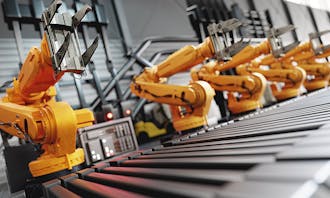Investing in a quality future
2020-04-15
3 min read
In 1999, a NASA Mars Climate Orbiter disappeared after entering the red planet’s atmosphere. The NASA review board investigated and found that the software failed because an engineer forgot to convert some data to metric units. Overlooking one measurement cost NASA millions and delayed important research. Mistakes in calculations might not always cost millions, but in manufacturing maintaining a high quality is vital to remain competitive. Here, we’ll explore how manufacturers can start a new revolution in quality control.
Over the last few years manufacturing companies across the globe have invested in advanced technologies in the race to realise Industry 4.0. This technology, connected to the Internet of Things (IoT), allows companies to tap into vast amounts of data about facility efficiency and see an accurate representation of everything that is happening inside the factory.
This smart technology can help manufacturers to improve accuracy and efficiency, but more automation does not automatically result in higher quality products. As customers demand more high-quality goods, manufacturers are making quality control a top priority, creating a new focal point in this industrial revolution — Quality 4.0.

Quality 4.0
This new revolution merges traditional quality control processes with Industry 4.0 technologies to improve productivity across the supply chain. For example, by monitoring the quality of machinery, processes and raw materials, manufacturers can ensure that every stage of the assembly line is optimised before production begins. This can reduce waste, improve efficiency and reduce the overall carbon footprint of the line.
Manufacturers of any size can benefit from better quality assurance. It eliminates the possibility of human error at multiple stages of production, sensors can detect any issues in real time and alert staff before an entire batch of products become defective.
Improving visibility during inspection can also optimise quality assurance. Implementing machine learning, for example, can improve fault detection because it will learn what a good and bad product looks like without human input. The more products it sees, the better it becomes at detecting faults.
A new category
Historically, quality control systems are large and expensive and cannot be installed without the assistance of a vision systems integrator. This process can be long and expensive, and it will only monitor product quality at the end of an assembly line increasing the risk of defective products.
In 2018, Israeli start-up company Inspekto unveiled the S70, the world’s first autonomous machine vision system to change how manufacturers complete quality assurance (QA). The cost-effective AI enabled system can be implemented at multiple stages of the assembly line and includes cameras, lenses and lighting to improve accuracy during inspection. Investing in technology like the S70 gives quality control back to manufacturers and helps them to deliver higher quality products.
NASA was able to learn from its expensive experience with human error and eventually completed several successful missions to Mars. As more manufacturers invest in technology to realise Industry 4.0, they must consider the role of quality control at every stage of production to improve productivity and reduce costly mistakes.



